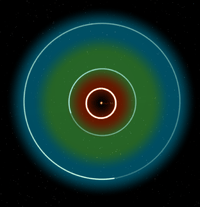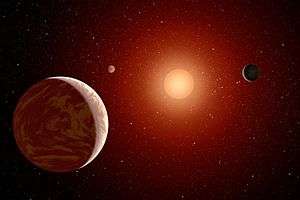Wolf 1061
| Observation data Epoch J2000 Equinox J2000 | |
|---|---|
| Constellation | Ophiuchus |
| Right ascension | 16h 30m 18.05803s[2] |
| Declination | –12° 39′ 45.3232″[2] |
| Apparent magnitude (V) | 10.10[3] |
| Characteristics | |
| Spectral type | M3V |
| U−B color index | +1.20[3] |
| B−V color index | +1.60[3] |
| Variable type | BY Draconis[4] |
| Astrometry | |
| Radial velocity (Rv) | –21.22[5] km/s |
| Proper motion (μ) | RA: –94.81[2] mas/yr Dec.: –1183.43 mas/yr |
| Parallax (π) | 232.98 ± 1.60[2] mas |
| Distance | 14.00 ± 0.10 ly (4.29 ± 0.03 pc) |
| Absolute magnitude (MV) | 11.96 |
| Details | |
| Mass | 0.25[6][7] M☉ |
| Radius | 0.26[6] R☉ |
| Luminosity (bolometric) | 0.0079[6] L☉ |
| Luminosity (visual, LV) | 0.0014 L☉ |
| Temperature | 3,380 ± 20[7] K |
| Metallicity [Fe/H] | –0.02 ± 0.17[7] dex |
| Other designations | |
| Database references | |
| SIMBAD | data |
Wolf 1061 (also known as HIP 80824 and V2306 Ophiuchi) is an M class red dwarf star located about 13.8 light years away in the constellation Ophiuchus. It is the 36th closest known star system to the Sun and has a relatively high proper motion of 1.2 seconds of arc per year. Like many red dwarfs, it most likely has a long rotation period of more than 100 days, although it is difficult to measure accurately. Wolf 1061 is very stable and most likely does not have any significant activity such as sunspots or flares.[8] It also does not have any unusual spectroscopic features.[9] The star was first cataloged in 1919 by German astronomer Max Wolf when he published a list of dim stars that had high proper motions. Wolf 1061's name originates from this list.[10]
Planetary system

In December 2015, a team of astronomers from the University of New South Wales announced the discovery of three planets orbiting Wolf 1061. The planets were detected by analyzing 10 years of observations of the Wolf 1061 system by the HARPS spectrograph at La Silla Observatory in Chile. The team used archive radial velocity measurements of the star's spectrum in the HARPS data and, along with 8 years of photometry from the All Sky Automated Survey, discovered two definite planets with orbital periods of around 4.9 and 17.9 days and a very likely third with a period of 67.3 days.[9]
All three planets have masses low enough that they are likely to be rocky planets similar to the inner planets of the Solar System although their actual sizes and densities are currently unknown. However, this information could be determined if the planets happen to transit in front of Wolf 1061 when viewed from Earth. Because all three planets orbit close to the star and have short orbital periods, there is a chance that this will occur. The University of New South Wales team estimated the chances of a transit at around 14% for planet b, 6% for planet c, and 3% for planet d.[9]
One of the planets, Wolf 1061 c, is a super-Earth located near the inner edge of the star's habitable zone, which extends from approximately 0.073 to 0.190 AU.[11] It is the closest known potentially habitable planet to Earth after Proxima b.[12][13][14] The next planet out, Wolf 1061 d, could be marginally habitable depending on its atmosphere's composition as it orbits just beyond the habitable zone.[9]
| Companion (in order from star) |
Mass | Semimajor axis (AU) |
Orbital period (days) |
Eccentricity | Inclination | Radius |
|---|---|---|---|---|---|---|
| b | ≥1.36 ± 0.23 M⊕ | 0.035509 ± 0.000007 | 4.8876 ± 0.0014 | unknown | — | 1.44 (estimated) R⊕ |
| c | ≥4.25 ± 0.37 M⊕ | 0.08427 ± 0.00004 | 17.867 ± 0.011 | 0.19 ± 0.13 | — | 1.64 (estimated) R⊕ |
| d | ≥5.21 ± 0.68 M⊕ | 0.2039 ± 0.0002 | 67.27 ± 0.12 | 0.32 ± 0.16 | — | 2.04 (estimated) R⊕ |
See also
References
- ↑ "Astronomers discover closest potentially habitable planet: Wolf 1061c". ScienceAlert.com. 17 December 2015. Retrieved 17 December 2015.
- 1 2 3 4 van Leeuwen, F. (2007), "Validation of the new Hipparcos reduction", Astronomy and Astrophysics, 474 (2): 653–664, arXiv:0708.1752
 , Bibcode:2007A&A...474..653V, doi:10.1051/0004-6361:20078357.
, Bibcode:2007A&A...474..653V, doi:10.1051/0004-6361:20078357. - 1 2 3 Mermilliod, J.-C. (1986), "Compilation of Eggen's UBV data, transformed to UBV (unpublished)", Catalogue of Eggen's UBV data. SIMBAD, Bibcode:1986EgUBV........0M.
- ↑ Wolf 1961 at SIMBAD
- ↑ Nidever, David L.; et al. (August 2002), "Radial Velocities for 889 Late-Type Stars", The Astrophysical Journal Supplement Series, 141 (2): 503–522, arXiv:astro-ph/0112477
 , Bibcode:2002ApJS..141..503N, doi:10.1086/340570.
, Bibcode:2002ApJS..141..503N, doi:10.1086/340570. - 1 2 3 Wright, D.J; Wittenmyer, R.A.; Bentley, C.G.; Riedel, J.S.; Jinglin, Zhao (17 December 2015). "Three planets orbiting Wolf 1061". arXiv:1512.05154v1
 [astro-ph.EP].
[astro-ph.EP]. - 1 2 3 Rojas-Ayala, Bárbara; et al. (April 2012). "Metallicity and Temperature Indicators in M Dwarf K-band Spectra: Testing New and Updated Calibrations with Observations of 133 Solar Neighborhood M Dwarfs". The Astrophysical Journal. 748 (2): 93. arXiv:1112.4567
 . Bibcode:2012ApJ...748...93R. doi:10.1088/0004-637X/748/2/93.
. Bibcode:2012ApJ...748...93R. doi:10.1088/0004-637X/748/2/93. - ↑ Despite this, it has the variable star designation V2306 Oph and has been identified in the past as a BY Draconis variable with a magnitude range of 10.05−10.10. See: Samus, N. N.; et al., General Catalogue of Variable Stars (2007−2015), retrieved 2015-12-18.
- 1 2 3 4 5 "Three planets orbiting Wolf 1061" (PDF). Newt.phys.unsw.edu.au. Retrieved 17 December 2015.
- ↑ Wolf, M. (June 1919). "Katalog von 1053 staerker bewegten Fixsternen (Catalog of 1053 moving fixed stars)". Veroeffentlichungen der Badischen Sternwarte zu Heidelberg (in German). 7 (10): 195–219. Bibcode:1919VeHei...7..195W.
- ↑ "Stellar habitable zone calculator". University of Washington. Retrieved 17 December 2015.
- ↑ Davison, Cassy L.; White, Russel J.; Henry, Todd J.; Riedel, Adric R.; Jao, Wei-Chun; Bailey III, John I.; Quinn, Samuel N.; Justin R., Cantrell; John P., Subasavage; Jen G., Winters (2015). "A 3D Search for Companions to 12 Nearby M-Dwarfs". arXiv:1501.05012
 [astro-ph.SR].
[astro-ph.SR]. - ↑ Sarah Griffiths (17 December 2015). "'Super-Earth' is spotted just 14 light years away: Wolf 1061c is the closest 'habitable' planet outside our solar system ever found". Daily Mail.
- ↑ Stuart Gary (17 December 2015). "Potentially habitable super-Earth discovered orbiting star 14 light years from Earth". ABC News (Australia).
External links
| Wikimedia Commons has media related to Wolf 1061. |
- SIMBAD database entry
- Hipparcos database entry
- Simulated view of the Wolf 1061 system created by the University of New South Wales
